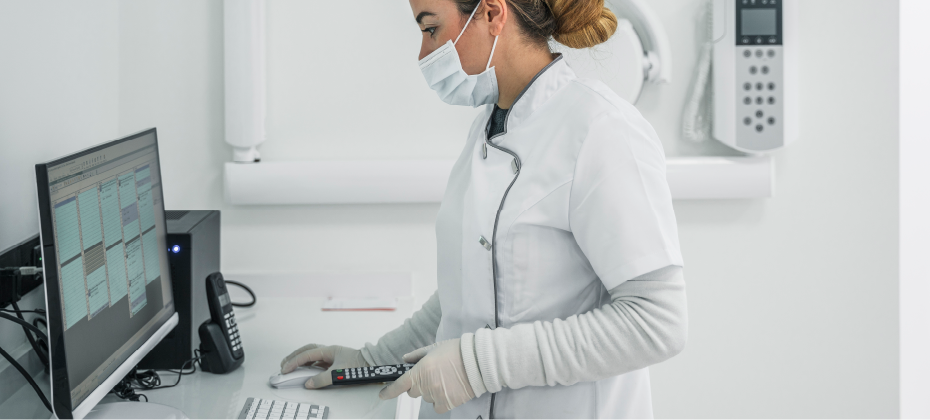Tag: Medicare

Tracking down missing health coverage has always been challenging for providers, but proposed changes to the Affordable Care Act and Medicaid could make it even tougher. If the reforms take effect, as many as 13.7 million Americans could lose health insurance over the next decade. With more patients cycling in and out of coverage, many will turn up for care without knowing their coverage status, leaving them at risk for bills they can't afford and exposing providers to denials and revenue loss. Insurance verification has traditionally relied on Social Security Numbers (SSN). As the industry moves away from this approach, providers need faster, more reliable ways to confirm health insurance without SSNs. Health insurance without an SSN? The challenge of missing SSNs in patient records For decades, the SSN was a go-to data point for verifying insurance coverage. In the absence of a national patient identifier, it served as a consistent way to match individuals to their insurance records across health systems and payers. However, many patients do not have SSNs, and concerns about data privacy, duplication and identity theft led providers and payers to phase out SSNs. Although SSNs may still be collected during enrollment for administrative use, industry best practice now discourages using SSNs unless absolutely necessary. Recognizing the need for more secure and trustworthy identifiers, many payers have moved away from SSNs. For instance, in 2018, Medicare replaced SSN-based Health Insurance Claim Numbers with Medicare Beneficiary Identifiers (MBIs). These are now the primary means of checking a person's identity for Medicare transactions like billing, eligibility status and claim status. Commercial health plans have followed suit, relying more heavily on member IDs and internal identifiers for billing and eligibility and avoiding SSNs in patient records in line with privacy rules set out in the Health Insurance Portability and Accountability Act. As a result, SSNs are disappearing from patient records and payer databases. The question for providers is how to accurately verify insurance without SSN access. The impact of unidentified insurance on claims and reimbursement When active insurance coverage is overlooked, providers lose the opportunity to bill for care. Some patients will be incorrectly assigned self-pay status, triggering unnecessary billing cycles or charity write-offs. Others get care without providing their coverage information at the time of care, especially in fast-moving outpatient and emergency departments. Either way, the revenue is at risk in situations like these. Providers lose time and revenue. Teams are forced to reprocess claims, track down retroactive coverage, and appeal denials that could have been avoided. Missed coverage also takes a toll on patients, who now owe more than $220 billion in medical debt. And with cost concerns prompting four in ten patients to consider skipping care when they don't receive a price estimate, missing coverage is more than a paperwork problem – it's a clear threat to health and well-being. Case study: How UCHealth saved over $3.5 million by reducing accounts sent to collections with billable insurance. Strategies to identify health insurance without an SSN As the use of the SSN in medical billing declines, providers are looking for new and better tools to find insurance coverage. Digital technology and data integration make it possible to verify insurance without SSN use. Here are a few of the most effective strategies: 1. Using probabilistic matching and third-party data Advanced coverage discovery platforms now use probabilistic matching to connect patients to payers. These tools analyze data points like name, address, date of birth and phone number to identify likely matches. Instead of needing a patient's exact identifiers, they calculate match confidence based on data quality and historical payer data. 2. Leveraging health information exchanges (HIEs) Another option is to connect to regional or statewide HIEs to check insurance details shared across health systems, payers and public programs. This is especially valuable for transient or underserved populations who often move between providers and may not always carry updated insurance cards. 3. Patient self-service portals with identity validation At the front end, patient self-service tools offer opportunities to collect insurance information before a visit. Identity validation technology helps confirm the person's identity without requiring an SSN. Patients can scan an insurance card, update coverage details or answer verification questions within the portal. This reduces the workload for front desk staff and ensures better data before the patient arrives. Automated tools to streamline insurance discovery While patient access tools help patients confirm their coverage details, automated back-end solutions are essential for identifying insurance when information is incomplete or missing. Intelligent coverage discovery platforms can predict and verify active coverage without relying on SSNs, using demographic inputs like name, address and date of birth. These platforms run real-time or batch searches across multiple proprietary databases, combining search best practices, historical claims data and payer response patterns to flag likely matches. At the point of scheduling or registration, automated eligibility checks help identify billable coverage early, reducing errors, manual work and missed reimbursement opportunities. Experian Health's Coverage Discovery® exemplifies this approach, uncovering commercial, Medicare and Medicaid coverage that may have been unknown or forgotten. By identifying primary, secondary and tertiary coverage, it flags accounts that might otherwise be written off or sent to charity. Not only does this help maximize reimbursement revenue, but it also automates the self-pay scrubbing process and reduces the number of accounts sent to bad-debt collections. In 2023 alone, the platform identified billable coverage in more than 30% of self-pay accounts, resulting in over $25 million in found coverage. This level of automation is especially critical as policy changes continue to disrupt coverage stability. Proactive alerts can flag patients previously marked as self-pay but now linked to valid insurance, helping providers course-correct before claims go unpaid. Better patient matching, better outcomes As insurance coverage becomes more complex, providers need smarter and more efficient ways to verify it. Automated platforms like Coverage Discovery identify active insurance using minimal patient data, improving accuracy and reducing dependence on SSNs. When active coverage isn't found, Patient Financial Clearance helps fill the gap, screening for Medicaid eligibility or identifying patients who may qualify for charity care. Together, these tools give providers a more complete financial picture and ensure patients are connected to the coverage or support they need. The result is not just cleaner claims and faster payments, but better patient and provider outcomes. With more than a fifth of patients experiencing delays in healthcare because of issues verifying insurance information, improving coverage accuracy is a win for everyone. Find out more about how Coverage Discovery can help healthcare providers reduce bad debt by verifying patients' health insurance coverage without SSNs. Learn more Contact us

In July this year, the Centers for Medicare & Medicaid Services (CMS) reported that a data breach in a contractor's network may have compromised the data of more than 600,000 current Medicare beneficiaries. The breach, which occurred in May 2023, involved a vulnerability in file transfer software that enabled an unauthorized party to access beneficiaries' personally identifiable information (PII) and protected health information (PHI). Some patients were issued with new Medicare Beneficiary Identifiers (MBIs) following the incident. The contractor also offered two years of Experian credit monitoring at no cost to those affected. However, providers may see an increase in patients who are confused or concerned about using their MBI card. Experian Health's MBI Lookup service can help providers ensure that Medicare eligibility verification remains as efficient as possible. Thousands of beneficiaries issued new MBI numbers In response to the breach, CMS announced that 47,000 individuals would be mailed new MBI cards with new MBI numbers. However, as 612,000 patients were affected by the breach, there may be a significant number of people whose MBIs may change without notice. Since these individuals will not be able to use their old MBIs when trying to find Medicare coverage and benefits, there could be confusion among patients and providers who rely on MBIs to confirm a patient's eligibility for Medicare coverage. It could also affect billing processes and claim status inquiries. Experian Health reached out to CMS for clarification and received the following guidance: If a Medicare beneficiary's MBI number has changed, then their old (now inactive) MBI will return an AAA72 error when attempts are made to confirm coverage using the HIPAA Eligibility Transaction System (HETS). The HETS 270/271 platform will accept historical 270 requests that use the patient's new MBI. Old MBI numbers will only be accepted if that number was active during the Date(s) of Service noted on the request. Providers should note that some patients may inadvertently use invalid MBI numbers and review processes for verifying Medicare eligibility accordingly. Verifying Medicare eligibility with Experian Health's MBI Lookup tool Verifying active coverage can be a painstaking process, but it's a vital step to confirm that planned services will be covered by the patient's insurance provider. If a patient is unaware or cannot demonstrate eligibility for Medicare, then the provider cannot make a claim for reimbursement, and the patient may be left to pay a bill they cannot afford. Finding active coverage helps providers reduce the risk of bad debt. Experian Health's Insurance Eligibility Verification speeds up this process by accurately confirming coverage at the time of service. The process comes with an optional MBI Lookup feature, which checks transactions against MBI databases to see if the patient may be eligible for Medicare. If the patient has forgotten their MBI card, the tool will check to see if they're included in the database, using their name, date of birth, and Social Security Number (SSN) or Health Insurance Claim Number (HICN). The MBI Lookup service triggers on 270/271 transactions in the following cases: Where the transaction fails because the subscriber is not found or their MBI number or other identification is missing or invalid (a “Traditional Medicare Failure”) Where a commercial 270 inquiry returns a “Medicare Advantage Plan” or “Managed Care Plan” indication on the “Other Payer” or “Other Coverage” section of the 271 response Where a commercial 270 transaction returns a failed response and the patient is aged 65 or older. If the provider's system attempts to use a patient's old number, and the patient does not realize that they have a new number or card, MBI Lookup will find and verify their new MBI. When the tool is triggered, it finds active and verified MBI numbers in 60% of cases on average. Find coverage faster with automated discovery tools Kate Ankumah, Principal Product Manager of Eligibility Verification and Alerts at Experian Health, says the automated MBI Lookup service has proven especially useful during times of change: “Providers relied on this service to verify Medicare coverage quickly when the pandemic hit, just as the industry was adjusting to the use of MBIs instead of their legacy HICN. Now, MBI Lookup can help providers smooth out the impact of data breaches involving Medicare beneficiaries with minimal fuss. It's a reliable way to give patients clarity without placing any undue burden on staff.” Insurance Eligibility Verification can be used alongside other automated coverage identification tools, such as Coverage Discovery®. Coverage Discovery scans government and commercial payer databases throughout the patient journey to find any previously unknown or forgotten coverage, eliminating the need for manual inquiries. Using multiple sources of data and tried-and-tested algorithms, these tools work together to locate coverage for patients, giving patients peace of mind and helping providers avoid uncompensated care. Both tools can be accessed via the eCareNext® platform, so staff can view eligibility responses and manage work queues through a single interface. And of course, this recent breach is a stark reminder of the need to protect patient data. Using a single vendor with integrated software and data solutions can help reduce the risk of data getting into the wrong hands. Find out more about how Experian Health's Eligibility Verification solution and MBI Lookup tool can help providers verify active coverage and give patients peace of mind following a data breach.

U.S. hospitals have been stuck with more than $745 billion in uncompensated care costs for the past 2 decades, and the number continues to grow. Other factors like patients relocating, changing employers, and coverage renewals make recovering debt even harder. The recent end in COVID-19 funding has also made it more important than ever for healthcare providers to find missing insurance coverage. Finding insurance coverage can be complicated and time-consuming, especially in an already complex reimbursement landscape. However, it doesn't have to be. That's where Coverage Discovery comes in. Coverage Discovery is the only comprehensive coverage identification solution across the full revenue cycle continuum. It covers the entire patient process and uses multiple proprietary data repositories, advanced search heuristics, and machine learning matching algorithms to search government and commercial payers to find previously unknown insurance coverage. This includes identifying accounts that may be submitted for immediate payment as primary, secondary or tertiary coverages. This automated coverage identification solution can search for unidentified coverage pre-service, at the point of care, and post-service. It also scans for insurance coverage continuously - to maximize reimbursements and minimize accounts sent to collections and to charity. In 2022, Coverage Discovery tracked down previously unknown billable coverage in more than 28.1% of self-pay accounts and found more than $64.6 billion in corresponding charges. Learn more about this solution: It's time to reduce bad debt and improve cash flow. Identifying hidden insurance coverage is the first step to managing insurance denials and your organization’s healthcare financial performance. A solution like Coverage Discovery can help healthcare organizations save time, money and alleviate staffing shortages. To learn more about how Coverage Discovery can benefit your healthcare organization, contact us.

On July 28, the US House of Representatives voted in favor of extending Medicare telehealth flexibilities after the COVID-19 public health emergency ends. If enacted, the Advancing Telehealth Beyond COVID-19 Act will allow beneficiaries to continue to access telehealth services at any site, including their home, until December 31, 2024. Coverage for a wider list of telehealth practitioners, delivery at specific clinics, audio-only telehealth, and remote behavioral health and hospice care would also continue. After a quick implementation period at the start of the pandemic, providers spent the last two years refining telehealth delivery. However, a question mark remained about telehealth’s post-pandemic prospects. The new legislation offers welcome certainty around reimbursement, at least until December 2024. More significantly, it’s further confirmation that telehealth is likely to become a permanent fixture in modern healthcare delivery. What does that mean for providers? Telehealth is here to stay Throughout the pandemic, remote and virtual care proved an effective way for providers to maintain relatively stable service delivery and limit gaps in care. It even helped to tackle inequitable access to care by making it easier for rural and underserved communities to speak to their doctor. Now, patients and providers alike are familiar with the benefits of telehealth. It’s an expected component of the overall healthcare experience. For the American Telehealth Association, the vote is “a significant step forward in providing much-needed stability in access to care for millions of Americans… We cannot allow patients to lose access to telehealth post-pandemic, and this bill will provide stability through 2024, while giving Congress time to address how to make the policies permanent.” As telehealth is gradually stitched into the fabric of the US healthcare system, providers should consider the following three actions to maximize the opportunities that come with delivering virtual and remote care: 1) Review the digital patient journey and increase telehealth access Telehealth is more than just a video visit – a truly virtual patient care experience starts from the moment the patient books their appointment all the way through to patient billing. Recent data from Experian Health and PYMNTS found that a third of patients chose to fill out registration forms for their most recent healthcare visit using digital methods, while 61% of patients said they’d consider changing healthcare providers to one that offers a patient portal. Prioritizing the use of digital channels could therefore boost patient attraction and retention, as well as efficiency and productivity. Integrating telehealth platforms with online scheduling software means patients can choose how and when to book their appointment, and appointment options are synced with physician calendars for maximum efficiency. Similarly, providers can ease friction when patients are registering for a telehealth visit by offering digital, automated and mobile-friendly registration. 2) Prioritize personalized patient outreach and engagement While many patients are now familiar with telehealth services, many may not be aware that it’s an option or may be unsure of how it works. Patient engagement strategies are essential in communicating to patients that telehealth services are available. By providing clear information about how the visit will work, how to use the technology and how to prepare, providers can help patients understand the process more clearly so they get the most out of their visit. This is especially important for patients who may be unable to attend in-person visits (e.g., due to location, disability, or lack of transportation or childcare). Telemedicine helps these patients take a more active role in their health and healthcare journey, in turn closing gaps in care. It also creates opportunities for remote patients to access experts that they’d otherwise be unable to see. Consumer data helps providers build patient engagement and outreach strategies based on reliable demographic, behavioral, psychographic and financial information. As telehealth services grow, a tool like ConsumerView enables providers to segment, identify and communicate with different audiences so that patients receive the most relevant message at the most useful time. 3) Explore automation for efficient telehealth billing Keeping track of telehealth reimbursement regulations has been one of the key challenges for providers as telehealth services have expanded. Flexibility reduced some of the barriers to scaling telehealth services, but did leave the door open to variation in payer requirements, coding changes and geographical coverage. The new legislation would maintain the status quo for a while longer. But looking ahead, any further changes to telehealth reimbursement rules, combined with greater telehealth utilization, could leave providers with an administrative mess to clear up if they don’t have robust processes in place. Those that utilize claims management and billing tools now will be best placed to manage what may follow. Automation can ease the burden in several ways. For example, with Coverage Discovery and eligibility verification solutions, providers and patients can confirm coverage eligibility early, which will speed up collections further down the line. Another option is to use automated healthcare claims management software to ensure every telehealth claim is submitted correctly the first time. With Experian Health’s customization function, telehealth alerts can be automatically checked so providers know whether the patient is covered for virtual care. As telehealth services gain a permanent place in the healthcare ecosystem, providers should act now to optimize patient-facing services and back-end processes. Failure to do so could cause patients to look elsewhere for the healthcare experience they desire and lead to lost revenue opportunities. Contact Experian Health today to discover how data-driven insights and automation can help providers bolster their telehealth offerings to maximize reimbursements.

“Experian Health’s speed and ability to speak our business language definitely impressed us,” said ACS president, Tim Anderson. “Some of the claims were valid for only a few more weeks, and we were able to submit them in plenty of time. This is the best, fastest platform we’ve seen to reconcile duplicate and data-deficient records. It really helped us achieve the best possible resolution for our clients and our company.” Acadiana Computer Systems, Inc. (ACS) was contracted with numerous labs in Louisiana to submit billing claims, primarily to Medicare, for testing that occurred in the first months of the pandemic. Unfortunately, in the chaos and scramble to offer testing services as quickly as possible in nursing homes and testing sites, the labs struggled to collect needed information to submit valid claims – in particular the Medicare beneficiary’s MBI number, or even a Social Security number. As the pandemic response progressed, a similar challenge developed around the administration of vaccines, particularly in mass vaccination sites and other off-site vaccination centers. Providers struggled to get more than a name and maybe a birthdate, address, or phone number. This left a gap in ACS’ efforts to submit private insurance and Medicare reimbursement claims on behalf of their clients. ACS worked with Experian Health and our Universal Identity Manager (UIM) platform, delivering the Experian Single Best Record (ESBR) – the matching of records through aggregation of disparate information and delivering a single record that accurately identifies separate records that belong to one person. The platform uses multiple data sources to verify, match and consolidate disparate records into one “best record.” ACS assembled the records requiring more identifying data and prepared them for secure transfer to Experian Health. Experian Health securely accepted more than 75,000 patient records and ran them through the UIM platform in 24 hours. It was critical to assign an SSN to as many individual records as possible, and to confirm an associated MBI number for Medicare billing, if applicable. Results included: 69% assigned unique records 12% identified as duplicate records With the information delivered back from the matched records, ACS had all the necessary data needed to continue the billing process. Within a week claims were submitted, expected to exceed $20 million in collections when the process is completed. The ACS group was experienced, savvy and data ready. Their expertise enabled an elegant and efficient exchange and complemented Experian Health’s capabilities. ACS expects to continue to use Experian Health’s UIM platform throughout the pandemic and also for mitigating duplicate records and preparing claims for submission. Learn more about how our Universal Identity Manager (UIM) platform can help your organization eliminate duplicate patient records.

Product featured in this article: Coverage Discovery As of the end of March 2021, more than 53 million Americans have been fully vaccinated, allowing for cautious optimism as we prepare for the next phase of the COVID-19 journey. Unfortunately for pharmacists, the vaccination program has compounded many of the challenges of the last 12 months. Shots may be free to patients, but someone has to pay for them – and getting reimbursed is proving to be a major pain. Complicated billing processes, extra billing audits and mountains of extra paperwork, rejected claims and slow payments are not exclusive to pharmacies helping vaccinate America. With the coronavirus pandemic continuing to muddy the insurance landscape, getting hold of missing dollars is challenging. Healthcare reimbursements haven’t been straightforward for other providers either: widespread coverage loss and uncompensated care is putting extra strain on hospital revenue cycles. With the coronavirus pandemic continuing to muddy the insurance landscape, getting hold of missing dollars is challenging. Providers must find ways to quickly and accurately determine each patient’s coverage status to minimize bad debt. Navigating the complex world of post-COVID healthcare coverage What does the reimbursement landscape look like, one year on? After a long wait, elective procedures are back. But the surge in patient volumes means providers must be on their toes to keep track of coverage. The process for doing so must be streamlined and precise. Ramping up capacity to verify and check coverage without burdensome paperwork is a must. Patient intake is under pressure. More patients are coming through the doors as a result of elective services and vaccination programs (though not always to their usual facility). COVID-19 hasn’t gone away, and with pockets of infection spikes, safety remains a top priority. Capturing adequate insurance information in this context is no mean feat. Running automated coverage checks as soon as the patient arrives will minimize face-to-face contact during admissions and avoid delays. Patient access and collections staff are overburdened. Manual checks are difficult when staff are operating remotely or in a socially distanced environment, and patient information might be incomplete. Automated self-pay scrubbing can help handle the volume. A tool with built-in reporting can also offer insights on workflow and productivity, to help spot opportunities for quicker claims processing. New digital healthcare technologies aren’t always covered by insurers. Telehealth, a life raft during COVID-19, tends to be covered less often by private insurers, compared to Medicare and Medicaid. Coverage checks must factor this in to avoid errors and wasted time. Providers should opt for tools that sweep for payer updates to telehealth coverage to avoid unnecessary delays or denials. Employment levels may be inching upwards again, but tracking coverage remains a challenge as patients start new jobs with new health plans. In addition, checking for Medicare coverage in the midst of changing codes and protocols is time consuming and confusing. A third-party resource such as Coverage Discovery can look for all coverage options and make sure the right bill goes to the right payer. Find missing dollars with Coverage Discovery Hospitals, pharmacists and other healthcare providers can’t afford to continue losing money at a time when every dollar is needed to prepare for “after COVID-19.” Experian Health’s Coverage Discovery is a proven system for tracking down missing coverage quickly and easily, to avoid unnecessary revenue loss. Using billions of data assets and intelligent confidence scoring, it combs through multiple government and commercial payer accounts to maximize actionable coverage. Staff can trust the outputs and focus their attention where it’s really needed. By making coverage identification more efficient and accurate, it’s a shot in the arm for providers in need of faster reimbursements. Contact us to see how Coverage Discovery can be easily integrated into your revenue cycle, so you can maximize reimbursements over the coming weeks and months.

At the beginning of the year, the healthcare industry moved away from Medicare identifiers based on Social Security Numbers (SSNs), in favor of more secure Medicare Beneficiary Identifiers (MBIs). As with any large-scale change program, the shift was unlikely to be completely clear sailing. But with the coronavirus pandemic landing shortly after the 21-month transition period was due to conclude, the switchover has been rougher than expected. Impacted Care Care providers are discovering newly eligible Medicare beneficiaries who haven’t yet received their card, while existing beneficiaries have misplaced theirs. Without a valid MBI number, patients risk delayed access to care, while the admin process to sort it out can be stressful, especially for already-vulnerable senior populations. For providers, the extra work and delayed reimbursements are particularly unwelcome when COVID-19 is already putting pressure on services and squeezing revenue. Unprecedented intake conditions where staff and patients are trying to limit face-to-face contact makes it difficult to complete the usual coverage checks. As a result, providers are missing revenue opportunities they cannot afford, while incurring additional downstream costs when collections are delayed. Experian Health clients are optimizing Coverage Discovery to speed things up. Case study: how one healthcare provider is finding missing Medicare coverage faster For example, the southeast division of a national health care system, with 1700+ beds and $1.6B in revenue, needed better ways to find MBIs when Health Insurance Claim Numbers (HICNs) were phased out. Assisting Medicare patients with tracking down their MBIs was time-consuming and error-prone. They came to Experian Health to find a more efficient way to check Medicare coverage. Jason Considine, Experian Health’s Senior Vice President for Patient Collections and Engagement, says: “We knew we could help because we already had Medicare coverage history through our historical repository. As a test, we were given a control set of known Medicare patients without MBIs, and were charged with finding those patients’ MBIs and Medicare coverage.” Experian Health’s Coverage Discovery tool was used to batch-process the control set. This took less than a day, as the tool scans more than one million accounts daily, using historical and demographic data, synthesized with multiple proprietary data sources, to find unknown or forgotten coverage. In this case, the resulting data was collated via batch files, but could be integrated with other coverage and collections tools, such as eCareNext, which automates the more repetitive and hands-on pre-registration tasks. Coverage Discovery found 60% of the Medicare coverages with MBIs, plus additional coverages. This enabled the provider to file claims that would otherwise have been nearly impossible and very time consuming. The provider’s next steps will be to integrate Coverage Discovery with eCareNext, and roll it out to more of sites in the system. Could Coverage Discovery help your organization find missing MBIs? Capturing better insights into productivity, financial results, and staff workflows is always valuable. But in the current crisis, tool that maximize reimbursement and automating the tasks that take up staff time is essential. Through our historical data repository, Experian Health’s Coverage Discovery already contains many patient MBIs – and it’s continually updated. We can help you search for Medicare coverage and make sure your clients find their MBIs, easing pressure off your revenue cycle management teams during this extremely challenging time. Request a review of Coverage Discovery and improve your coverage and collections processes.

There is no doubt the healthcare industry has taken a financial beating as a result of COVID-19. But there is a glimmer of hope for providers. Several new announcements were recently made attached to the Coronavirus Aid, Relief, and Economic Security (CARES) Act, specifically around reimbursements attached to COVID care for the uninsured. The financial stimulus, intended to stabilize hospital finances as providers face short-term revenue reductions due to the cessation of non-urgent procedures and the increased costs for personal protective equipment, has earmarked a portion of the $100B established for CARES to reimburse healthcare providers at Medicare rates for the treatment of uninsured COVID patients. The guidance does not indicate specifically how much money will be set aside to reimburse these claims. The big question? How long will the funds last and how quickly will providers act? With both unemployment, translating into more uninsured individuals, and COVID cases on the rise, the dollars could be exhausted quickly. A recent study by Kaiser estimates the total payments to hospitals for treating uninsured patients under the Trump administration policy would range from $13.9B to $41.8B. While Medicare payments are about half of what private insurers pay on average for the same diagnoses, estimates surrounding COVID care can be in excess of $50k for those severe cases where struggling patients spend weeks in the intensive care unit on a ventilator. Bottom line, it’s likely the funds will be distributed quickly, especially when factoring in unemployment skyrocketing. As of April 30, more than 30M Americans have filed jobless claims amid the coronavirus outbreak. The all-new portal opened on April 27 for sign-ups, and providers can begin submitting claims electronically on May 6. Healthcare providers who have conducted COVID-19 testing of uninsured individuals or provided treatment to uninsured individuals with a COVID-19 diagnosis on or after February 4, 2020 can request claims reimbursement through the program electronically and will be reimbursed at Medicare rates, subject to available funding. A complete list of FAQs regarding the CARES Act and reimbursements are accessible on the Health Resources & Services Administration website. But what other tips and considerations should providers contemplate as they attempt to get their fair share? Here are three actions to optimize a provider’s chances of claiming reimbursements for the uninsured. Automate the insurance check. Providers must attest that they have checked for healthcare coverage eligibility and confirm the patient is uninsured. If they fail to check, they may be denied. Providers must verify that the patient does not have coverage such as individual, employer-sponsored, Medicare or Medicaid coverage, or any other payer options that will reimburse for the COVID-19 testing and/or care of that patient. There are ways to automate this step, completing a second eligibility check to attest that the patients have no coverage before providers submit claims to the government. Scan for the social security number (SSN), if possible. While there may be instances where COVID patients entered a facility and were quickly admitted with no formal registration process, the CARES Act states an SSN and state of residence, or state identification/driver's license is needed to verify patient eligibility. If these pieces of information are not captured, providers need to attest that they have attempted to capture this information before submitting a claim. The patient may be long gone, but there are still ways to attempt to retrieve a patient’s SSN after they have exited the healthcare facility. Providers should know that claims submitted without an SSN and state of residence, or state identification/driver's license may take longer to verify for patient eligibility. Again, with the possibility that these funds could quickly be exhausted, it is in the provider’s best interest to submit claims that are as clean and validated as possible. Act fast. Recall the Small Business Administration's Paycheck Protection Program (PPP) — a coronavirus relief fund for small businesses that was also established under CARES? The $350B allocated by the bill was quickly depleted in days. While these funds were going to individuals in entirely different industries, there is no concrete projections on how long healthcare providers can expect the $1B fund to cover reimbursements for the uninsured. So, providers need to act now, and fast, by tapping into automation and auditing solutions that will optimize their chances of securing their fair share.

This time last year, the Centers for Disease Control and Prevention and hospitals across the country weren’t quite ready for the flu season, which turned out to be the deadliest in 40 years. The flu and complications arising from it resulted in the deaths of more than 80,000 people. Hospitals felt the brunt of the 2017-2018 epidemic early. Hospital and medical center staffs were forced to work overtime, setting up triage tents and treating flu patients in recovery rooms. Alabama declared a state of emergency, and doctors in California had to treat patients in hallways. Experts predict a milder flu season this year, partly due to an updated flu vaccine that protects against H3N2, which was the severe strain that dominated last year’s flu season. While it's hopeful that this year’s flu season will be better, it's always a busy time for hospitals and providers, so they should be sure they're using the most efficient healthcare IT solutions to streamline their workflow. Greater efficiency is key When it comes to efficiency, hospitals should take a cue from Martin Luther King Jr. Community Hospital in Los Angeles, which collaborated with Experian Health to streamline patient registration and insurance verification. Before the collaboration, MLKCH had to consult websites and make phone calls to confirm a patient's insurance eligibility, which was time-consuming. The hospital has a large Medicaid and managed care population, which means employees had to consult both a state website and a health plan website. The hospital also had a high-traffic emergency department and limited front-line staff to handle the incoming flow of patients. Additionally, employees performed manual quality assurance, which is a time-consuming task. Understanding its challenges, Experian Health was able to help the hospital streamline its system to improve efficiency in insurance verification through Coverage Discovery. It also helped the hospital improve patient registration with Registration QA, which has improved data quality and patient registration accuracy. Since MLKCH integrated Coverage Discovery and Registration QA into Cerner, it has saved precious time when it comes to validating patient and payment information. “We have a lot of returning patients to our emergency room, so once we check that patient in, their eligibility automatically runs in the background and our staff doesn’t have to go into another website to check their eligibility," said Lori Westman, patient access manager at MLKCH. “This has saved us two to three minutes of our registration time.” “We average about 300 patients every 24 hours,” she continued. “Heading into flu season, they're expecting to hit a 400-per-day volume, so the fact that we can take off two to three minutes at least on half of our registrations is going to speed up the work for the team that much faster, to have a turnaround time that much better for more patients to come through.” Managing the season Only 42 percent of Americans got a flu vaccine last year — painfully shy of the CDC’s 70 percent target. Misconceptions and fears about the vaccination and its effectiveness can keep people from getting it, which only increases the spread of the flu. Flu season is always going to be a busy time for healthcare providers. But finding ways to manage staff and resources and work more efficiently is going to help hospitals and other facilities better manage the busy season. Learn more about Experian Health’s Patient Access solutions.